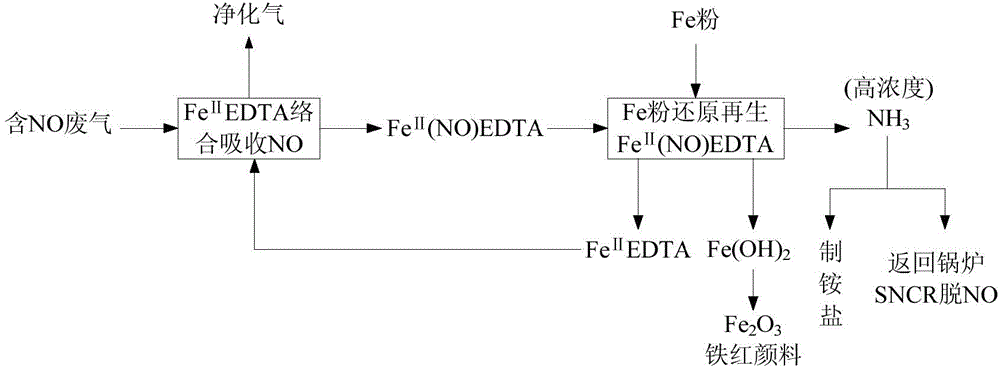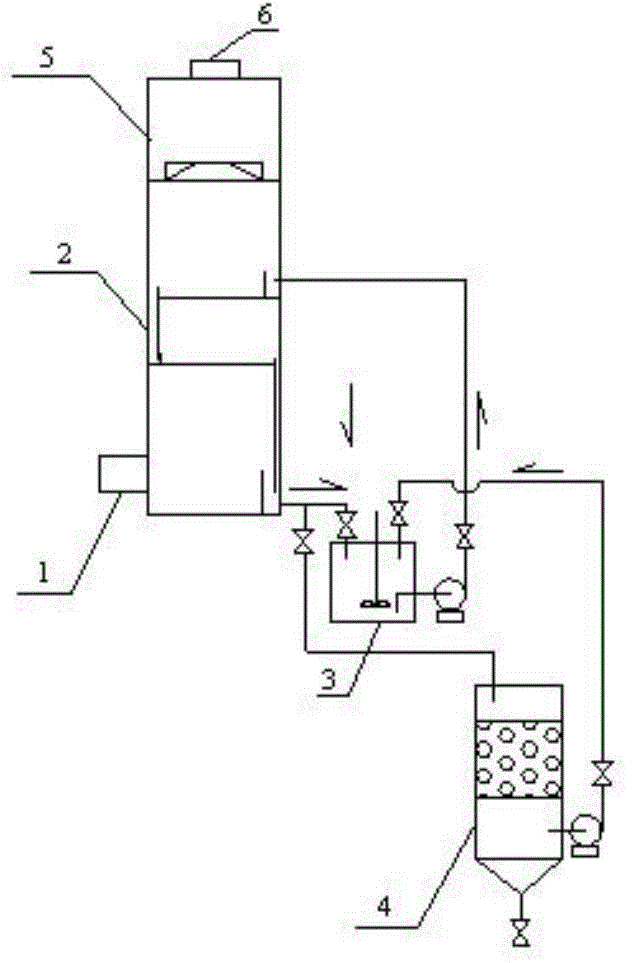Method for removing nitric oxides from boiler smoke
A technology for nitrogen oxides and boiler flue gas, which is applied in the field of flue gas purification, can solve the problems of increasing the difficulty of process operation and increasing equipment investment, and achieves the effects of good utilization value, easy industrialization, and simple process operation.
- Summary
- Abstract
- Description
- Claims
- Application Information
AI Technical Summary
Problems solved by technology
Method used
Image
Examples
Embodiment 1
[0037] Fe Ⅱ EDTA complexation absorbs NO in simulated flue gas: a sieve plate absorption tower with a diameter of 100mm and a height of 1200mm is used as the absorber, with 2 layers of sieve plates built in, and the opening rate is 17%. Simulated NO exhaust gas flow rate 20m 3 / h, including NO500×10 -6 , the absorption solution Fe Ⅱ EDTA concentration is 25mmol·L -1 , the circulation volume is 80L / h, the reaction temperature is 323K, the initial pH of the complex solution is 5.5, and the NO removal rate is 97%. The regeneration device uses iron filings packed bed reactor with a diameter of 200mm and a height of 400mm, and the spray density is 0.2m 3 / (m 2 h), when 313K, 5% of the ammonia gas regenerated is absorbed by sulfuric acid to obtain ammonium sulfate, and the regenerated Fe Ⅱ The EDTA solution is recycled for absorption, and the denitrification efficiency is still around 97%.
Embodiment 2
[0039] Fe Ⅱ EDTA complexation absorbs NO in simulated flue gas: a sieve plate absorption tower with a diameter of 100mm and a height of 1200mm is used as the absorber, with 2 layers of sieve plates built in, and the opening rate is 17%. Simulated NO exhaust gas flow rate 20m 3 / h, including NO400×10 -6 , the absorption solution Fe Ⅱ EDTA concentration is 25mmol·L -1, the circulation volume is 80L / h, the reaction temperature is 323K, the initial pH of the complex solution is 5.5, and the NO removal rate is 98%. The regeneration device uses iron filings packed bed reactor with a diameter of 200mm and a height of 400mm, and the spray density is 0.4m 3 / (m 2 h), when 303K, the 5% ammonia gas that regenerates obtains ammonium sulfate with sulfuric acid absorption, and the Fe that regenerates goes out Ⅱ The EDTA solution is recycled for absorption, and the denitrification efficiency is still around 98%.
Embodiment 3
[0041] Fe Ⅱ EDTA complexation absorbs NO in simulated flue gas: a sieve plate absorption tower with a diameter of 100mm and a height of 1200mm is used as the absorber, with 2 layers of sieve plates built in, and the opening rate is 17%. Simulated NO exhaust gas flow rate 20m 3 / h, including NO500×10 -6 , the absorption solution Fe Ⅱ EDTA concentration is 30mmol·L -1 , the circulation volume is 100L / h, the reaction temperature is 323K, the initial pH of the complexing solution is 6.0, and the NO removal rate is above 97%. The regeneration device uses iron filings packed bed reactor with a diameter of 200mm and a height of 400mm, and the spray density is 0.6m 3 / (m 2 h), when 293K, 5% of the ammonia gas regenerated is absorbed by sulfuric acid to obtain ammonium sulfate, and the regenerated Fe Ⅱ The EDTA solution is recycled for absorption, and the denitrification efficiency is still around 96%.
PUM
 Login to View More
Login to View More Abstract
Description
Claims
Application Information
 Login to View More
Login to View More - R&D
- Intellectual Property
- Life Sciences
- Materials
- Tech Scout
- Unparalleled Data Quality
- Higher Quality Content
- 60% Fewer Hallucinations
Browse by: Latest US Patents, China's latest patents, Technical Efficacy Thesaurus, Application Domain, Technology Topic, Popular Technical Reports.
© 2025 PatSnap. All rights reserved.Legal|Privacy policy|Modern Slavery Act Transparency Statement|Sitemap|About US| Contact US: help@patsnap.com


